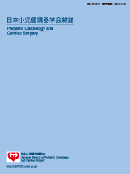Volume 29, Issue 6
Displaying 1-15 of 15 articles from this issue
- |<
- <
- 1
- >
- >|
Editorial
-
2013Volume 29Issue 6 Pages 275-276
Published: November 01, 2013
Released on J-STAGE: December 01, 2013
Download PDF (612K)
Guideline
-
2013Volume 29Issue 6 Pages 277-290
Published: November 01, 2013
Released on J-STAGE: December 01, 2013
Download PDF (1224K)
Review
-
2013Volume 29Issue 6 Pages 291-299
Published: November 01, 2013
Released on J-STAGE: December 01, 2013
Download PDF (1548K)
Original
-
2013Volume 29Issue 6 Pages 300-305
Published: November 01, 2013
Released on J-STAGE: December 01, 2013
Download PDF (992K) -
2013Volume 29Issue 6 Pages 309-315
Published: November 01, 2013
Released on J-STAGE: December 01, 2013
Download PDF (1402K) -
2013Volume 29Issue 6 Pages 316-321
Published: November 01, 2013
Released on J-STAGE: December 01, 2013
Download PDF (1132K) -
2013Volume 29Issue 6 Pages 322-327
Published: November 01, 2013
Released on J-STAGE: December 01, 2013
Download PDF (1661K) -
2013Volume 29Issue 6 Pages 331-338
Published: November 01, 2013
Released on J-STAGE: December 01, 2013
Download PDF (1185K)
Case Reports
-
2013Volume 29Issue 6 Pages 339-344
Published: November 01, 2013
Released on J-STAGE: December 01, 2013
Download PDF (2072K) -
2013Volume 29Issue 6 Pages 345-351
Published: November 01, 2013
Released on J-STAGE: December 01, 2013
Download PDF (2201K) -
2013Volume 29Issue 6 Pages 352-356
Published: November 01, 2013
Released on J-STAGE: December 01, 2013
Download PDF (1378K) -
2013Volume 29Issue 6 Pages 360-366
Published: November 01, 2013
Released on J-STAGE: December 01, 2013
Download PDF (1275K)
Editorial Comments
-
2013Volume 29Issue 6 Pages 306-308
Published: November 01, 2013
Released on J-STAGE: December 01, 2013
Download PDF (703K) -
2013Volume 29Issue 6 Pages 328-330
Published: November 01, 2013
Released on J-STAGE: December 01, 2013
Download PDF (686K) -
2013Volume 29Issue 6 Pages 357-359
Published: November 01, 2013
Released on J-STAGE: December 01, 2013
Download PDF (760K)
- |<
- <
- 1
- >
- >|
